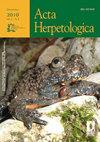A lizard acting as carrier of the amphibian-killing chytrid Batrachochytrium dendrobatidis in southern Brazil
IF 0.9
4区 生物学
Q4 ZOOLOGY
引用次数: 4
Abstract
Fungal infections are causing widespread population declines and extinctions in all vertebrate classes. Among them, an important fungal disease chytridiomycosis, caused by the pathogenic chytrid Batrachochytrium dendrobatidis ( Bd ). With an aquatic infectious phase, Bd does not survive desiccation for long, but may be transported by non-amphibian carriers. Such mechanism is key to understand amphibian-chytrid dynamics and may contribute to local amphibian conservation action plans. Therefore, we surveyed Bd in reptiles from two different Brazilian rainforests, looking for possible Bd carriers. We sampled 35 individuals belonging to 11 squamate families, five from the Atlantic Forest and 30 from the Amazon. We detected Bd in one adult lizard, Placosoma glabellum . This lizard feeds, shelters, and breeds in the leaf-litter, and moves between Atlantic Forest streams. Hence, it may be carrying Bd from stream to stream, and also spreading the pathogen to direct-developing amphibians, which have no contact with water bodies and are more susceptible to chytridiomycosis than aquatic species. This is the first record of a non-amphibian chytrid carrier in South America. We suggest that additional field and museum samplings will contribute to understand whether Bd can actually infect reptiles, and how reptile carriers can affect chytrid dynamics in the wild.在巴西南部,一种蜥蜴作为两栖动物的载体,杀死了树状突蛛(Batrachochytrium dendrobatidis)
真菌感染正在导致所有脊椎动物种群的大范围减少和灭绝。其中,一种重要的真菌病壶菌病,由致病性壶菌Batrachochytrium dendrobatidis(Bd)引起。在水生感染阶段,Bd不会在干燥状态下存活很长时间,但可能由非两栖动物携带者运输。这一机制是了解两栖动物壶菌动态的关键,可能有助于制定当地两栖动物保护行动计划。因此,我们调查了来自巴西两个不同雨林的爬行动物中的Bd,寻找可能的Bd携带者。我们对11个科的35个个体进行了采样,其中5个来自大西洋森林,30个来自亚马逊。我们在一种成年蜥蜴,即后颈原蜥身上检测到了Bd。这种蜥蜴在落叶中觅食、栖息和繁殖,并在大西洋森林的溪流之间移动。因此,它可能携带Bd从一条溪流传播到另一条溪流,并将病原体传播给直接发育的两栖动物,这些两栖动物与水体没有接触,比水生物种更容易感染壶菌病。这是南美洲首次记录到非两栖食糜船。我们建议,额外的野外和博物馆采样将有助于了解Bd是否真的会感染爬行动物,以及爬行动物携带者如何影响野生食糜的动态。
本文章由计算机程序翻译,如有差异,请以英文原文为准。
求助全文
约1分钟内获得全文
求助全文
来源期刊

Acta Herpetologica
ZOOLOGY-
CiteScore
1.20
自引率
12.50%
发文量
10
审稿时长
6 months
期刊介绍:
Acta Herpetologica, a journal open to academics all over the world, offers itself as a new site for the presentation and discussion of the most recent results in the field of research on Amphibians and Reptiles, both living and extinct. The official journal of the Societas Herpetologica Italica (S.H.I.), Acta Herpetologica publishes original works – extended articles, short notes and book reviews – mostly in English, dealing with the biology and diversity of Amphibians and Reptiles.
 求助内容:
求助内容: 应助结果提醒方式:
应助结果提醒方式:


